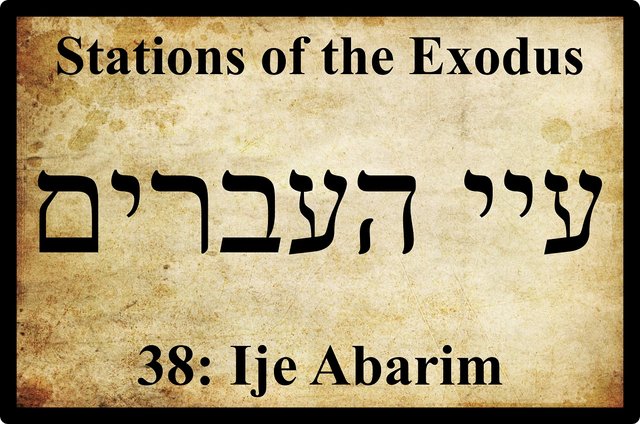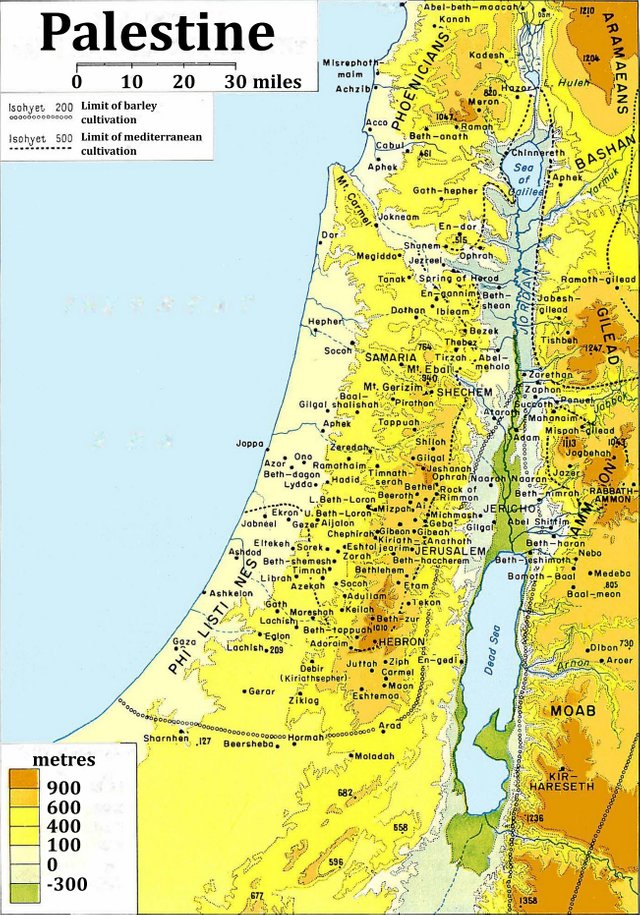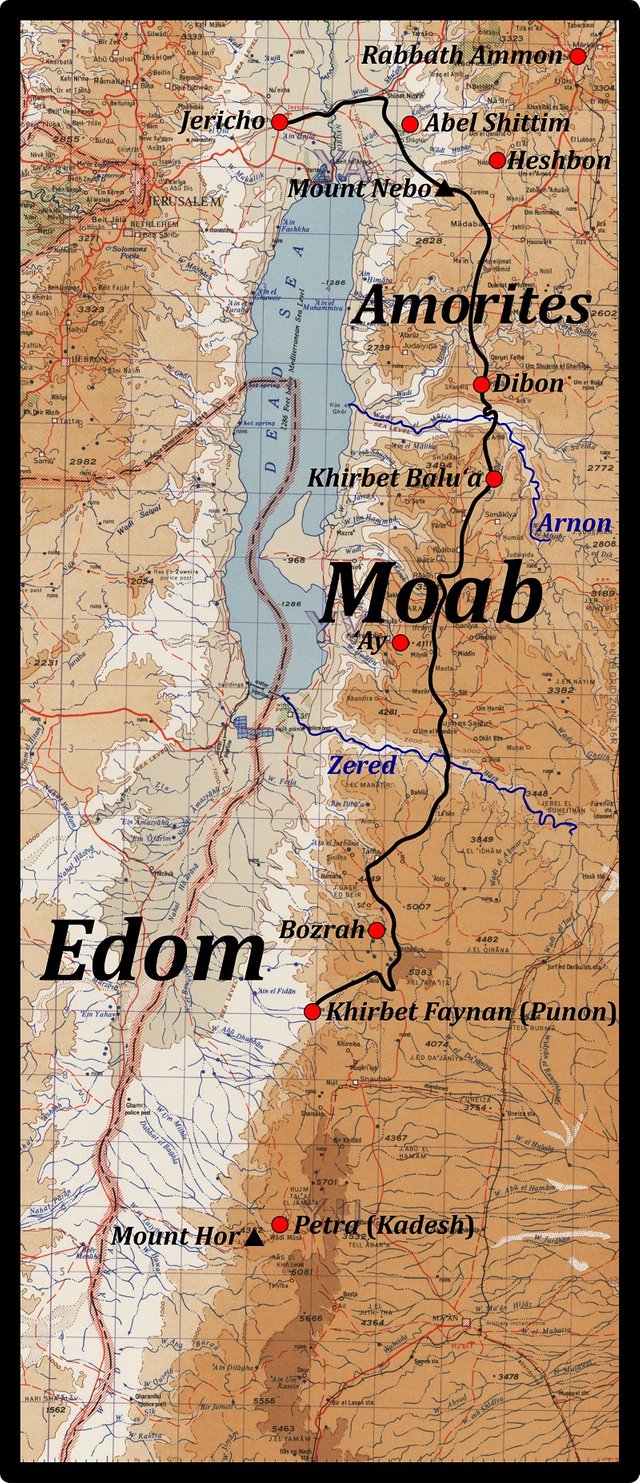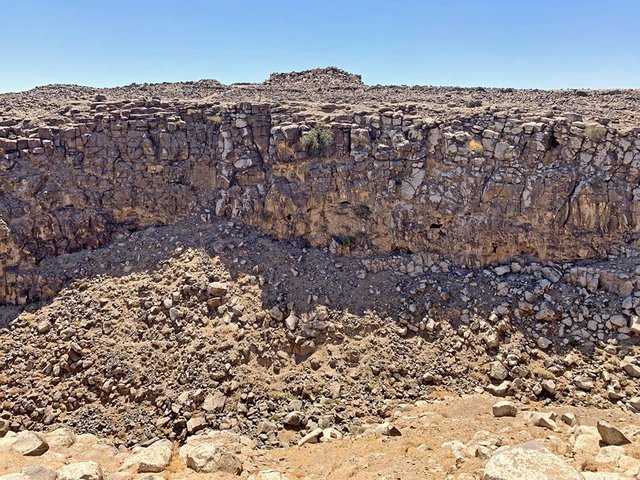
According to the Catalogue of Stations in Chapter 33 of the Book of Numbers, the thirty-eighth Station of the Exodus was a place called Ije Abarim—Ruins of Abarim (Strong 85, 87)—or, simply, Iim:
And they departed from Oboth, and pitched in Ijeabarim, in the border of Moab. And they departed from Iim, and pitched in Dibongad. And they removed from Dibongad, and encamped in Almondiblathaim. And they removed from Almondiblathaim, and pitched in the mountains of Abarim, before Nebo. They left the mountains of Abarim and camped on the plains of Moab by the Jordan across from Jericho. There on the plains of Moab they camped along the Jordan from Beth Jeshimoth to Abel Shittim (Numbers 33:44-49)
This station is also mentioned in the main Exodus narrative, in Numbers 21, but reconciling this more detailed account with the Catalogue of Stations in Numbers 33 is problematic:
And they journeyed from Oboth, and pitched at Ijeabarim, in the wilderness which is before Moab, toward the sunrising. From thence they removed, and pitched in the valley of Zared. From thence they removed, and pitched on the other side of Arnon, which is in the wilderness that cometh out of the coasts of the Amorites: for Arnon is the border of Moab, between Moab and the Amorites ... And from thence they went to Beer: that is the well whereof the Lord spake unto Moses ... And from the wilderness they went to Mattanah: And from Mattanah to Nahaliel: and from Nahaliel to Bamoth: And from Bamoth in the valley, that is in the country of Moab, to the top of Pisgah, which looketh toward Jeshimon.. (Numbers 21:11-20)
Pisgah and Nebo are generally considered to refer to one and the same mountain, an equation that is justified by a passage in Deuteronomy:
And Moses went up from the plains of Moab unto the mountain of Nebo, to the top of Pisgah, that is over against Jericho. (Deuteronomy 34:1)
So we have two different lists of toponyms between Ije Abarim and Nebo-Pisgah:
| Numbers 21 | Numbers 33 |
|---|---|
| Ije Abarim | Ije Abarim |
| Valley of Zared | Dibongad |
| Arnon | Almondiblathaim |
| Beer | The Mountains of Abarim |
| Mattanah | - |
| Nahaliel | - |
| Bamoth | - |
| Pisgah | Nebo |
In the previous article in this series, I asked which route the Israelites took as they left Edom and passed through Moab: the lowlying coastal route along the shores of the Dead Sea, or the inland route through the hilly region known as Mount Seir? The answer to this question would seem to be the latter.
Despite their discrepancies, the two passages in Numbers seem to agree that Ije Abarim lay close to the southern border of Moab—that is, the border between Edom and Moab.
There are, however, two other passages in the Old Testament which describe the route taken by the Israelites. In Deuteronomy 2-3, Moses recounts the passage through the wilderness. Once again, the details are not easily reconciled with those in the Book of Numbers:
And when we passed by from our brethren the children of Esau [Edomites], which dwelt in Seir, through the way of the plain from Elath, and from Eziongaber, we turned and passed by the way of the wilderness of Moab ... Now rise up, said I, and get you over the brook Zered. And we went over the brook Zered ... Thou art to pass over through Ar, the coast of Moab, this day: And when thou comest nigh over against the children of Ammon, distress them not, nor meddle with them: for I will not give thee of the land of the children of Ammon any possession ... Rise ye up, take your journey, and pass over the river Arnon: behold, I have given into thine hand Sihon the Amorite, king of Heshbon, and his land: begin to possess it, and contend with him in battle ... And I sent messengers out of the wilderness of Kedemoth unto Sihon king of Heshbon with words of peace, saying, Let me pass through thy land ... But Sihon king of Heshbon would not let us pass by him ... Then Sihon came out against us, he and all his people, to fight at Jahaz. And the Lord our God delivered him before us; and we smote him, and his sons, and all his people. And we took all his cities at that time, and utterly destroyed the men, and the women, and the little ones, of every city, we left none to remain: Only the cattle we took for a prey unto ourselves, and the spoil of the cities which we took. From Aroer, which is by the brink of the river of Arnon, and from the city that is by the river, even unto Gilead, there was not one city too strong for us: the Lord our God delivered all unto us: Only unto the land of the children of Ammon thou camest not, nor unto any place of the river Jabbok, nor unto the cities in the mountains, nor unto whatsoever the Lord our God forbad us. (Deuteronomy 2:8-37)
Finally, in Judges 11, Jephthah tells the King of the Ammonites:
Israel did not take the land of Moab or the land of the Ammonites. But when they came up out of Egypt, Israel went through the wilderness to the Red Sea and on to Kadesh. Then Israel sent messengers to the king of Edom, saying, ‘Give us permission to go through your country,’ but the king of Edom would not listen. They sent also to the king of Moab, and he refused. So Israel stayed at Kadesh. Next they traveled through the wilderness, skirted the lands of Edom and Moab, passed along the eastern side of the country of Moab, and camped on the other side of the Arnon. They did not enter the territory of Moab, for the Arnon was its border. Then Israel sent messengers to Sihon king of the Amorites, who ruled in Heshbon, and said to him, ‘Let us pass through your country to our own place.’ Sihon, however, did not trust Israel to pass through his territory. He mustered all his troops and encamped at Jahaz and fought with Israel. Then the Lord, the God of Israel, gave Sihon and his whole army into Israel’s hands, and they defeated them. Israel took over all the land of the Amorites who lived in that country, capturing all of it from the Arnon to the Jabbok and from the desert to the Jordan. (Judges 11:15-22)
More than thirty years ago, J Maxwell Miller of Emory University in Atlanta, Georgia, studied these four passages in an attempt to reconcile their differences. I follow his analysis in The Israelite Journey through (Around) Moab and Moabite Toponymy:
Even a casual reader will notice some confusion in these passages regarding whether the Israelites went through Moab territory or circled around the eastern (desert) side. (Miller 577)

Some Obvious Identities
Some of the toponyms mentioned in the Catalogue of Stations in Numbers 33 have obvious identities:
The exact names Dibon-gad, Almon-diblathaim, and Abel-shittim are also unique to this passage, but they clearly correspond to Dibon, Beth-diblathaim, and Shittim well known in other texts. It seems safe to associate Punon with Khirbet el-Feinan in Wādī el-Feinan and Dibon(-gad) with Dhībān immediately north of Wādī Mūjib. (Miller 581)
Miller then notes:
Davies identifies Iye-abarim with the present-day village of ‘Ay approximately ten kilometers southwest of Kerak. The possibility must be considered, however, that Iye-abarim ... was not a specific site—that is, that the name should be translated with full appellative force, something like “the ruins on the other side.” Certainly this is true of the Mountains of Abarim ... which would be the rugged western escarpment of the Moabite plateau at the northeastern corner of the Dead Sea. (Miller 581)
The Borders of Moab
Where were the borders of Moab?
The actual boundaries of Moab is one of the points of contention in the passages. For our purposes, Moab may be identified as the narrow strip of cultivable land paralleling the Dead Sea along its eastern side. It will be useful, moreover, to distinguish between Moab proper (the region south of the Arnon, present-day Wādī el-Mūjib) and northern Moab (the region north of the Arnon). Moab proper was isolated by geographical barriers—the steep Arnon/Mūjīb canyon on the north, the Dead Sea escarpment on the west, the Arabian desert on the east, and the Wādī el-Ḥesā canyon on the south. Northern Moab was easily accessible to the outside world, on the other hand, especially to the Israelites and the Ammonites ... It was contended, namely, that Moab had already lost territory north of the Arnon to the Amorites before the Israelites appeared on the scene and that the Israelites conquered this territory from the Amorite king Sihon. Israelite presence north of the Arnon could not be regarded as encroachment on either Moab or Ammon, therefore, according to this line of argument. The Arnon was already established as Moab’s northern boundary before the days of Moses, and Israel conquered the region north of this boundary fair and square from a non-Moabite, non-Ammonite king. (Miller 577-578)

From Punon to Dibon-Gad
As the crow flies, Khirbat el-Faynan (Punon) is about 103 km from Dhiban (Dibon-Gad). On foot, the distance is closer to 150 km. If the Israelites were covering 24-32 km per day (Hoffmeier 120), it is difficult to see how they could have travelled from Punon to Dibon-gad in only three stages (with overnight stops at Oboth and Ije Abarim). This suggests that the Catalogue of Stations in Numbers 33 is unreliable, and we should place more trust in the account given in Numbers 21. Until quite recently, this was the opinion of most Biblical scholars:
In their attempts to trace the Israelite rough through/around Edom and Moab, scholars usually give precedence to Num 21:10-20, the first of the four passages mentioned above. Not only does it come first in the biblical narrative; it seems to provide more specific geographical detail than any of the other three. The general consensus among literary critics also favored this approach until the 1970s. (Miller 578-580)
Today, however, the scholarly consensus is quite different:
We come finally to Num 21:10-20, which commentators and biblical cartographers have struggled with for years on the mistaken assumption that it is supposed to make geographical sense. but it simply does not, and recent studies by Mittmann, Van Seters, and Davies explain why ... Deuteronomy presupposes a peaceful journey through Edom and Moab; Judges has the Israelites going around through the desert; Numbers 21 conflates the two perspectives ... The result of all this, of course, is a geographical hodgepodge totally incomprehensible in terms of the geographical realities of southern Transjordan. (Miller 585 ... 587)
It seems, then, that we must set aside both accounts from the Book of Numbers and rely instead on the account in either Deuteronomy or Judges. Note that the two latter accounts are mutually incompatible: Deuteronomy describes a peaceful journey through Edom and Moab, while Judges has the Israelites avoiding both kingdoms and going through the desert instead. But these passages are not without their own difficulties. Deuteronomy 2 is internally inconsistent, while Judges 11 seems to present an independent account with a political agenda:
To summarize: Deuteronomy 2 combines competing traditions regarding Israel’s encounter with the peoples of Transjordan. The redactional process involved some loose correlations which probably are misleading—namely, the equation of the sons of Lot with Moab and Ar with the region south of the Arnon ... however, it is clear that the Israelites were understood to have passed through, rather than around, Moab proper. (Miller 583)
Note that Genesis 19:30-38 claims that the Moabites and the Ammonites were both descended from Lot through his two daughters, while Genesis 36 identifies the Edomites as descendants of Esau.

The passage in Judges 11 contradicts Deuteronomy 2 by having the Israelites avoid both Edom and Moab altogether.
In my opinion, the best hypothesis I can come up with is as follows:
The Israelites passed through Edom and Moab.
Moses never requested permission to pass through either of these kingdoms, and he never received permission from their rulers.
The Edomites and Moabites simply ignored the Israelites, seeing their passage as an event of little consequence and one that posed no threat to their security.
Later, however, it was in the interest of Jewish scholars to make the point—obviously tendentious (Miller 589)—that the Israelites had gone out of their way to respect Edomite and Moabite sovereignty, that they had requested permission to pass through their kingdoms, and that when this was not granted, they had respected the decision and had chosen an alternative route through the desert, one which did not violate Edomite or Moabite territory.
If we adopt this as our working hypothesis, then Deuteronomy 2 should be given precedence, but we should not be too hasty to dismiss the other accounts entirely.
Deuteronomy 2
Summarizing the opening chapters of the Book of Deuteronomy, we arrive at the following possible itinerary:
| Deuteronomy 2 | Possible Identity |
|---|---|
| The Brook Zered | Wādī el-Ḥesā |
| Ar | Khirbet Bālū‘a |
| The River Arnon | Wādī el-Mūjib |
| Kedemoth | Kadesh |
| Jahaz | Khirbet Libb |
Ar is another problematic toponym: was it part of Moab or a city in Moab? Miller thinks the latter and after a lengthy discussion, comes to the following conclusion:
Since all of the biblical references to Ar Moab are ambiguous in one way or another, there can be no claim of certainty regarding the location of Ar. However, in addition to the fact that Khirbet Bālū‘a meets the main criteria—that is, it represents a prominent city which was located on the Arnon and was occupied during the Late Bronze and Iron Ages—it also makes reasonable sense when the three crucial poetical texts are considered individually. (Miller 594)

Kedemoth, from which Moses dispatches ambassadors to Sihon King of the Amorites, may have been an error for Kadesh, which we have identified with Petra:
Although there was a place called Kedemoth in northern Moab (Josh 13:17-20, 21:37; 1 Chr 6:34), the mention here of “the wilderness of Kedemoth” is not entirely convincing. The reader was never informed that the Israelites had reached the wilderness of Kedemoth, and Kedemoth is not mentioned in any of the other passages pertaining to the Israelite journey through the Transjordan. Possibly some confusion has occurred here between Kedemoth and Kedesh (cf. Deut 1:46). (Miller 583)
Ije Abarim
So where was Ije Abarim? If it was the next station after Oboth, then it must have lain approximately 24-32 km beyond Oboth. We don’t know where Oboth was, but in the previous article we speculated that it may have been located somewhere in the vicinity of Bozrah, the future stronghold of Edom. About 30 km north of Bozrah is the Wādī el-Ḥesā, which is generally identified with the Brook Zered (Kitchen 194). We should, therefore, seek Ije Abarim somewhere near this wadi. This actually supports Numbers 21, which places Ije Abarim between encampments at Oboth and in the valley of Zared (which is surely the same as Zered).
But if the Israelites halted just south of the Wādī el-Ḥesā, would they have halted again in the valley of this same wadi after travelling just a few more kilometres? This consideration—together with the fact that Numbers 33 mentions Ije Abarim but not Zered, while Deuteronomy 2 mentions Zered but not Ije Abarim—leads me to surmise that Ije Abarim and Zered refer to one and the same station, located somewhere in the valley of the Wādī el-Ḥesā. At least one scholar, Yohanan Aharoni, places Ije Abarim in this valley. He locates it several kilometres further upstream than I would prefer, but this is because he accepts the view that the Israelites circumvented Moab altogether (Aharoni, Map 63).

A site in the valley of the Wādī el-Ḥesā would still be about 60 km short of Dibon-Gad, so there must have been at least one more station before Dibon-Gad—possibly two. Perhaps these included one or more of the other places mentioned in Numbers 21: Beer, Mattanah, Nahaliel and Bamoth (Clarke 686).
And that is the best I can do.
To be continued ...
References
- Yohanan Aharoni, A F Rainey (translator & editor, The Land of the Bible: A Historical Geography, The Westminster Press, Philadelphia (1979)
- Adam Clarke, The Holy Bible ... With a Commentary and Critical Notes, Volume 1, G Lane & C B Tippett, New York (1846)
- James K Hoffmeier, Ancient Israel in Sinai: The Evidence for the Authenticity of the Wilderness Tradition, Oxford University Press, Oxford (2005)
- Kenneth A Kitchen, On the Reliability of the Old Testament, William B Eerdmans Publishing Company, Grand Rapids MI (2003)
- J Maxwell Miller, The Israelite Journey through (Around) Moab and Moabite Toponymy, Journal of Biblical Literature, Volume 108, Number 4, pp 577-595, The Society of Biblical Literature, Atlanta, GA (1989)
- James Strong, Hebrew and Chaldee Dictionary, in The Exhaustive Concordance of the Bible, Eaton & Mains, New York (1890)
Image Credits
- Palestine (Old Testament): M Celle (artist), The Jerusalem Bible: Reader’s Edition, © Darton, Longman & Todd, Ltd and Doubleday & Company, Inc, Fair Use
- The Western Sinai Peninsula: University of Texas Libraries, Perry-Castañeda Library Map Collection, Jerusalem, D Survey, Great Britain War Office and Air Ministry (1960), Public Domain
- Wādī el-Mūjib (The Arnon Stream): © Berthold Werner, Creative Commons License
- Khirbet Bālū‘a: © Balu‘a Regional Archaeology Project, Fair Use
- Wādī el-Ḥesā (The Brook Zered): © 2020 Google, Fair Use
